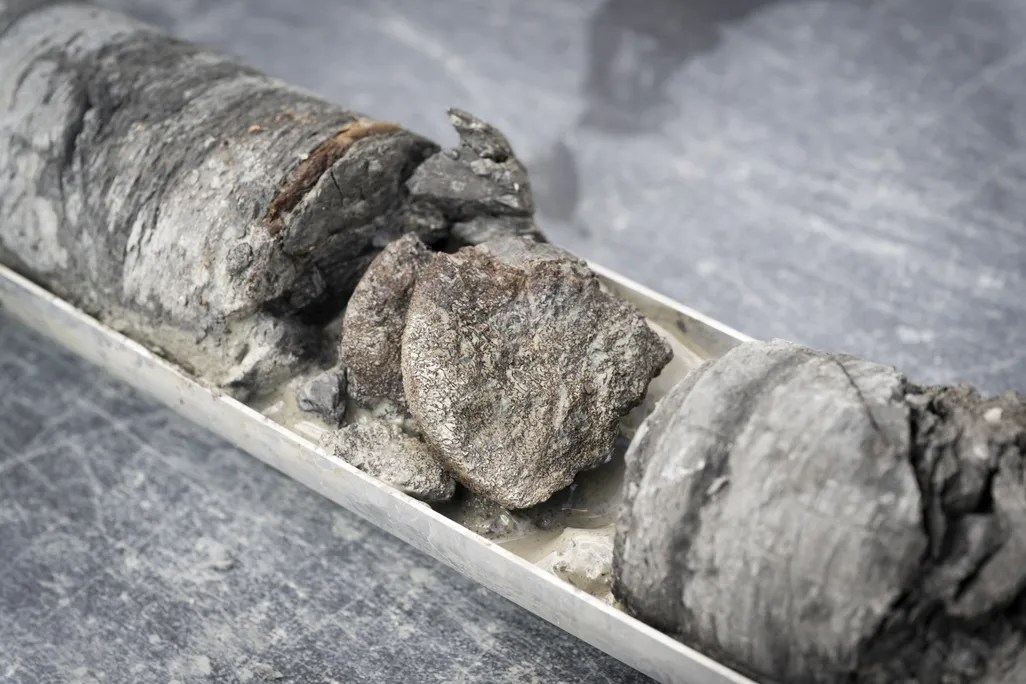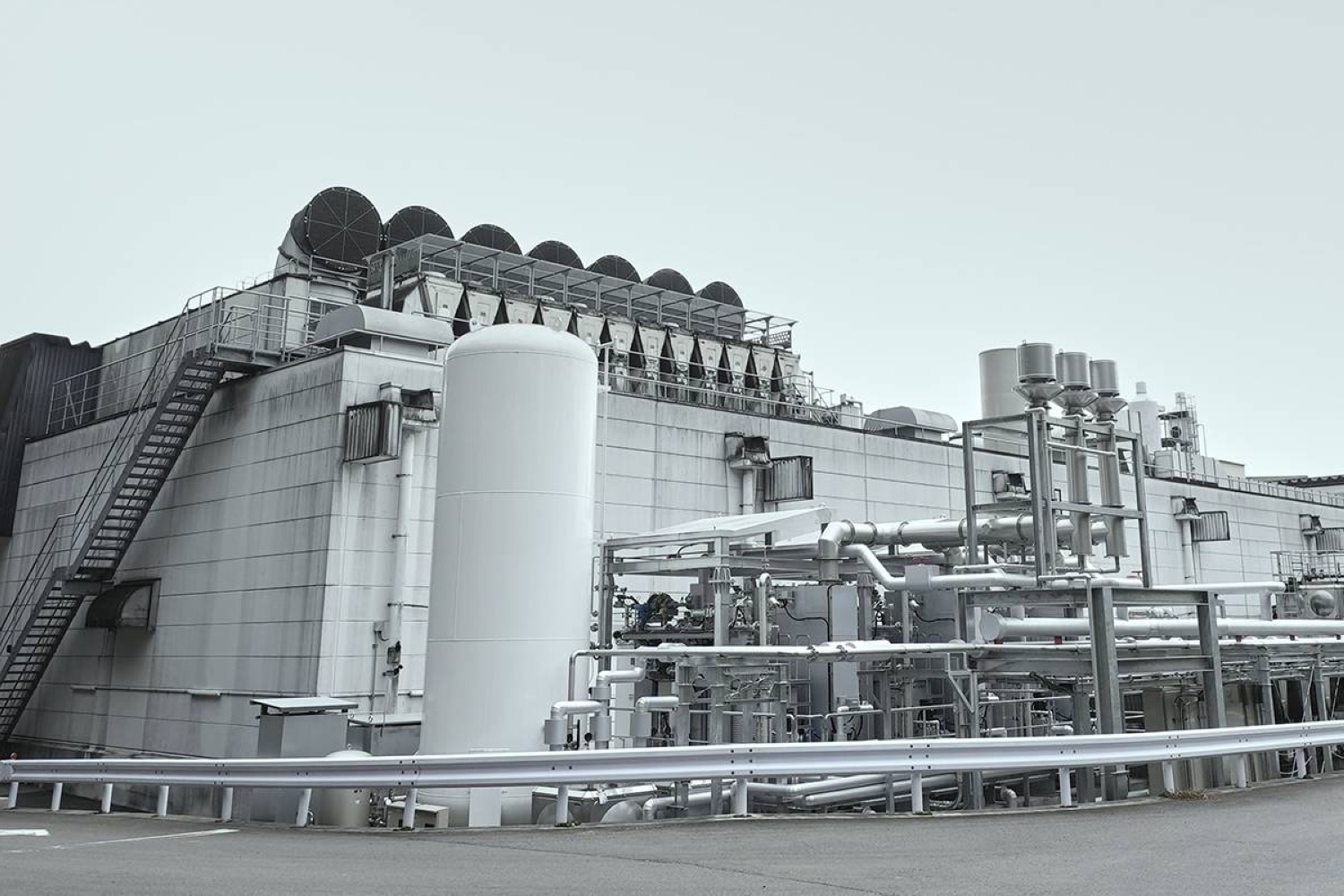The partial vertebra appeared inside a 2.5-inch-diameter column of rock that researchers drilled, earning the title of the oldest and deepest dinosaur fossil found in Denver
/https://tf-cmsv2-smithsonianmag-media.s3.amazonaws.com/accounts/headshot/SarahKuta.png)
Sarah Kuta - Daily Correspondent
July 10, 2025

For decades, visitors have flocked to the Denver Museum of Nature and Science to see the fossilized bones of prehistoric behemoths like Diplodocus and Stegosaurus on display.
As it turns out, another dinosaur was lurking beneath their feet the whole time.
This week, the 125-year-old museum announced that paleontologists had unearthed a 67.5-million-year-old partial dinosaur bone from underneath the institution’s parking lot. They describe their fitting find in a new paper called “Denver’s deepest dinosaur,” published June 1 in the journal Rocky Mountain Geology.
The discovery was made in January, as crews conducted tests to see if the museum could make the switch from natural gas to geothermal energy for its heating, air conditioning and hot water. While this work was underway, scientists used the opportunity to drill down and extract a core sample to learn more about the region’s geology.
Need to know: What is a core sample?
Scientists collect core samples—long cylinders of sediment, rock or ice—to gather data on an environment or Earth’s geology over time. They can teach researchers about conditions of the ground, ocean or atmosphere from millions of years ago.
Buried 763 feet deep beneath the parking lot on the north side of the museum, they found a partial vertebra that once belonged to a plant-eating dinosaur. (Coincidentally, two dinosaur sculptures stand guard over the parking garage located nearby.)
What are the odds of finding a dinosaur bone in a core sample that measures just 2.5 inches in diameter? “It’s basically like winning the lottery and getting struck by lightning on the same day,” says James Hagadorn, the museum’s curator of geology, in the statement.
/https://tf-cmsv2-smithsonianmag-media.s3.amazonaws.com/filer_public/ec/1f/ec1f1f3f-6cfe-44a5-b2f3-1d5a3254887d/eas2025-2_020.jpg) Earth scientist Bob Raynolds (shown here) describes the find as "nothing short of magical."
Rick Wicker / Denver Museum of Nature and Science
Earth scientist Bob Raynolds (shown here) describes the find as "nothing short of magical."
Rick Wicker / Denver Museum of Nature and Science
Bob Raynolds, an Earth scientist who’s been with the museum for 35 years, echoed that sentiment, describing the discovery as “nothing short of magical.”
It’s not clear which species the bone came from. But experts suspect the creature may have been similar to Thescelosaurus or Edmontosaurus, two dinosaurs known to have roamed the region around the same time.
/https://tf-cmsv2-smithsonianmag-media.s3.amazonaws.com/filer_public/13/4e/134ec8c1-98e6-4a6a-a5d8-bb37c5403fdf/ios20027_finally_the_rockies-jpg.jpg) During the Late Cretaceous, Denver had a warm, tropical climate.
Gary Stabb, Johnson and Raynolds
During the Late Cretaceous, Denver had a warm, tropical climate.
Gary Stabb, Johnson and Raynolds
The bone—which the museum says is the deepest and oldest dinosaur fossil found within Denver city limits—is now on display as part of the “Discovering Teen Rex” exhibition. “As far as I know, [this is] the only dinosaur bone from a core in the world that you can go see,” Hagadorn tells KUSA’s Bobbi Sheldon and Bryan Wendland.
The vertebra was located in a layer of rock created during the Late Cretaceous, just before the dinosaurs went extinct. Today, Denver has a semi-arid climate, but at that time, the region was a “sub-tropical ever-wet setting,” the researchers write in the paper. The region had a warm, rainy climate, complete with lush, green plants like palm trees and vines.
The core sample—and the dinosaur bone found inside it—offers a brief window into what Denver was like millions of years ago.
“The layers of this core change from the areas outside of a river to a swamp, and then to a pond, and the dinosaur bone is right on the edge of that pond,” Hagadorn tells KUSA. “Was that dinosaur drinking water out of that pond or munching on plants nearby? It’s just something cool to imagine.”
/https://tf-cmsv2-smithsonianmag-media.s3.amazonaws.com/filer_public/2d/91/2d912b77-d4fe-4f5b-a926-d2d07a4d6e8e/eas2025-2_026.jpg) Geologists found the fossil 763 feet beneath the parking lot in a core sample.
Rick Wicker / Denver Museum of Nature and Science
Geologists found the fossil 763 feet beneath the parking lot in a core sample.
Rick Wicker / Denver Museum of Nature and Science
Colorado sits atop the Morrison Formation, a layer of rock across much of the Western U.S. dating to the Late Jurassic Period, so the museum’s vertebra discovery wasn’t a total surprise. Numerous fossils and footprints have been found throughout the state over the years, including in and around the capital city.
In 1993, for example, crews building Denver’s professional baseball stadium discovered a four-inch rib and some bone fragments, which gave rise to the Colorado Rockies’ mascot, Dinger the dinosaur. More recently, in 2017, crews working in the suburb of Thornton unearthed the most complete Torosaurus ever found. Two years later, in Highlands Ranch, Triceratops bones turned up during construction near a retirement facility.
And roughly 20 minutes west of Denver, Dinosaur Ridge—a nonprofit outdoor museum—protects more than 250 dinosaur tracks. The area, which is part of the Dakota Hogback, has also been the site of numerous landmark discoveries, including fossils unearthed in the late 19th century that led to the naming of creatures like Apatosaurus, Stegosaurus and Allosaurus.
So, will more dinosaur bones be unearthed far beneath the Mile High City in the future? Almost certainly, Hagadorn tells Westword’s Kristen Fiore.
“This area is rich in fossils as well as untapped underground geology,” he says. “More discoveries await.”
.png)




